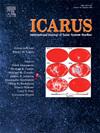火星南半球短暂涡旋和沙尘暴的气候学
IF 2.5
2区 物理与天体物理
Q2 ASTRONOMY & ASTROPHYSICS
引用次数: 0
摘要
本文研究了火星南半球瞬变涡旋的行为,并说明了涡旋如何塑造沙尘暴的年周期和空间分布。对瞬态涡旋的研究是基于火星气候探测仪对亮度温度的非最低点测量,这是关于地表附近涡旋活动的最直接和可靠的信息来源。通过对8.6个火星年的亮度温度进行最小二乘分析,确定了瞬变涡旋的基本特性,得出了比以前更完整的南半球涡旋活动描述。空时谱以纬向波数为1 ~ 4、周期小于5个太阳的涡旋为主。波4分量比以前认识到的要重要得多。每年观测到一个由三个不同的涡旋活动期组成的年循环。在l = 0-75°和125-200°存在浅斜压波(温度上)。在此期间,斜压波被地表附近振幅相对较小的深的3.3溶胶正压波所取代。瞬态涡旋强烈地影响了火星尘埃活动数据库和火星沙尘暴序列数据集中的离散沙尘暴的年周期。在涡旋活动的正压阶段(Ls=75 ~ 125°),当地表附近的振幅很小时,沙尘暴是罕见的,其净面积可以忽略不计。相反,在涡旋活动的两个斜压阶段,风应力通常超过起尘所需的阈值,此时地表附近的振幅要大得多,导致沙尘暴净面积明显增加。由于西半球涡旋活动的持续风暴路径的存在,沙尘暴频繁发生在从奥尼亚地到玛格丽特地的走廊上。该走廊的沙尘暴密度随风暴路径强度和纬度的季节变化而变化。进一步的见解是通过巩固以前的研究结果而获得的。这项调查提高了我们对以南方冬至为中心的半年火星气候的理解,那时大气相对凉爽和清澈。本文章由计算机程序翻译,如有差异,请以英文原文为准。
Climatology of transient eddies and dust storms in the southern hemisphere of Mars
This paper examines the behavior of transient eddies in the southern hemisphere of Mars and illustrates how the eddies shape the annual cycle and spatial distribution of dust storms. The investigation of transient eddies is based on off-nadir measurements of brightness temperature by the Mars Climate Sounder, which are the most direct and reliable source of information about eddy activity adjacent to the surface. Basic properties of the transient eddies are determined through least-squares analysis of brightness temperatures spanning 8.6 Mars years, yielding a far more complete description of eddy activity in the southern hemisphere than was available previously. The space-time spectrum is dominated by eddies with zonal wavenumbers 1–4 and periods shorter than 5 sols. The wave-4 component is much more important than was previously recognized. An annual cycle comprising three distinct periods of eddy activity is observed each year. Shallow (in temperature) baroclinic waves are present at – and –. In the intervening period, the baroclinic waves are replaced by a deep, 3.3-sol, barotropic wave that has a relatively small amplitude near the surface. The transient eddies strongly influence the annual cycle of discrete dust storms cataloged in the Mars Dust Activity Database and the Mars Dust Storm Sequence Dataset. Dust storms are rare and their net area is negligible during the barotropic phase of eddy activity (–), when the amplitude near the surface is small. Conversely, the wind stress routinely exceeds the threshold required for dust lifting during the two baroclinic phases of eddy activity, when the amplitude near the surface is much larger, resulting in a conspicuous increase in the net area of the dust storms. Dust storms occur frequently in a corridor extending from Aonia Terra to Margaritifer Terra, owing to the presence of a persistent storm track of eddy activity in the western hemisphere. The density of dust storms in this corridor varies in response to the seasonal evolution in the strength and latitude of the storm track. Further insight is gained by consolidating results from previous studies. This investigation improves our understanding of the Martian climate in the half year centered on the southern winter solstice, when the atmosphere is relatively cool and clear.
求助全文
通过发布文献求助,成功后即可免费获取论文全文。
去求助
来源期刊

Icarus
地学天文-天文与天体物理
CiteScore
6.30
自引率
18.80%
发文量
356
审稿时长
2-4 weeks
期刊介绍:
Icarus is devoted to the publication of original contributions in the field of Solar System studies. Manuscripts reporting the results of new research - observational, experimental, or theoretical - concerning the astronomy, geology, meteorology, physics, chemistry, biology, and other scientific aspects of our Solar System or extrasolar systems are welcome. The journal generally does not publish papers devoted exclusively to the Sun, the Earth, celestial mechanics, meteoritics, or astrophysics. Icarus does not publish papers that provide "improved" versions of Bode''s law, or other numerical relations, without a sound physical basis. Icarus does not publish meeting announcements or general notices. Reviews, historical papers, and manuscripts describing spacecraft instrumentation may be considered, but only with prior approval of the editor. An entire issue of the journal is occasionally devoted to a single subject, usually arising from a conference on the same topic. The language of publication is English. American or British usage is accepted, but not a mixture of these.
 求助内容:
求助内容: 应助结果提醒方式:
应助结果提醒方式:


